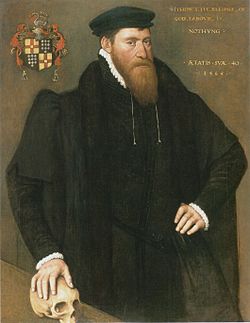John Lonyson facts for kids
Quick facts for kids
John Lonyson
|
|
|---|---|

Lonyson in 1565
|
|
| Master of the Mint | |
| In office 1571–1582 |
|
| Preceded by | Thomas Stanley |
| Succeeded by | Richard Martin |
| Personal details | |
| Born | 1525 |
| Died | 1582 |
| Resting place | St Vedast Foster Lane, London, England |
| Nationality | British |
| Occupation | Goldsmith |
John Lonyson (1525–1582) was an important English goldsmith during the time of Queen Elizabeth I. He also held a very important job as the Master of the Mint. This meant he was in charge of making all the coins for the country.
Contents
Early Life and Career
John Lonyson came from a family of goldsmiths. His family was originally from Flanders, a region in Europe. They had settled in King's Lynn, a town in Norfolk, England.
By 1552, John had finished his training in London. He became a full member of the Worshipful Company of Goldsmiths in May 1564. This was a powerful group for people who worked with gold.
Becoming Master of the Mint
In 1571, the person in charge of the Royal Mint passed away. The Royal Mint was the place where all coins were made. After this, the job was split between two people.
In April 1572, Queen Elizabeth's government chose Richard Martin to be the Warden of the Mint. John Lonyson was chosen to be the Master-Worker of the Mint.
What Did the Master of the Mint Do?
As the Master, John Lonyson had a big responsibility. He had to take raw gold and silver, called bullion, from merchants. Then, he would turn this bullion into new coins.
These coins had to be a specific weight and fineness (purity). All these rules were written down in a special agreement called an indenture. A small part of the gold and silver was kept by Lonyson and the Warden. This money covered their fees and the costs of running the Mint.
A Problem with the Coins
A problem came up with the coins Lonyson was making. People found that the coins were often lighter than they should be. They also had less pure metal than the rules said.
John Lonyson said that these small differences were allowed by his indenture. He claimed they were within the acceptable limits.
Why Coin Purity Mattered
The purity of coins was very important to Queen Elizabeth's government. Before her, kings like Henry VIII and Edward VI had made coins with less pure metal. This caused prices to go up, which was bad for the country. So, Elizabeth's government was very proud of having pure coins.
The problem with Lonyson's coins became a big deal. It was discussed by the most important people in the government.
The Investigation
Richard Martin, the Warden of the Mint, accused Lonyson of purposely making the coins lighter and less pure. He said Lonyson did this to make more money for himself.
In 1578, a special group of important government officials looked into the matter. This group included powerful people like Lord Burghley and Francis Walsingham.
The rules in Lonyson's indenture were not very clear. Because of this, he was not found guilty of doing anything wrong on purpose.
New Rules for Lonyson
Even though he wasn't found guilty, the government made new rules for Lonyson. He could only make coins under short-term agreements. These new agreements were very clear about how much metal he could keep for himself.
Lonyson accepted these new rules. He continued to work at the Royal Mint until he passed away.
Lonyson's Death
John Lonyson died in 1582. He was buried in a church called St Vedast Foster Lane in London. There is a monument there to remember him.
After Lonyson's death, Richard Martin, the Warden, took over his job. This meant that one person was again in charge of both roles at the Mint.

